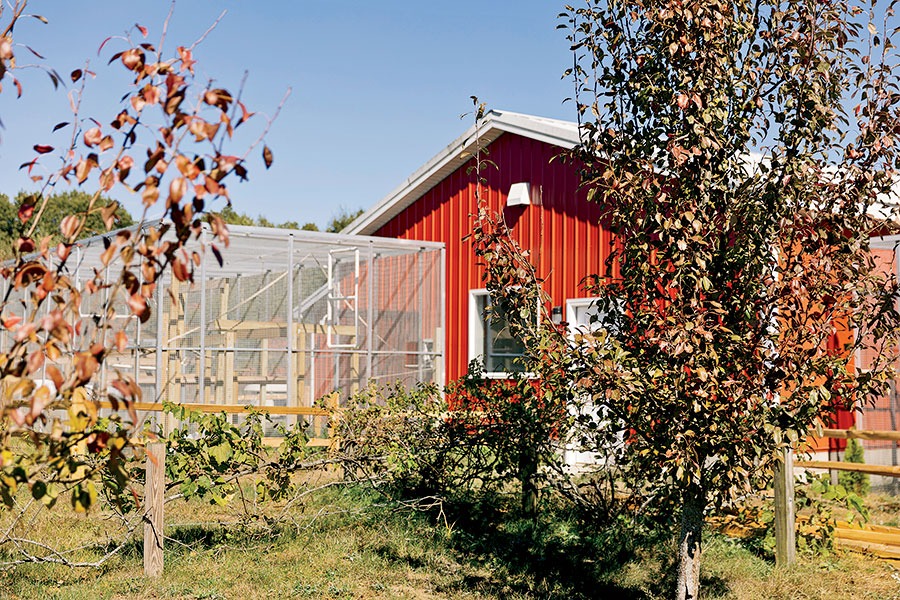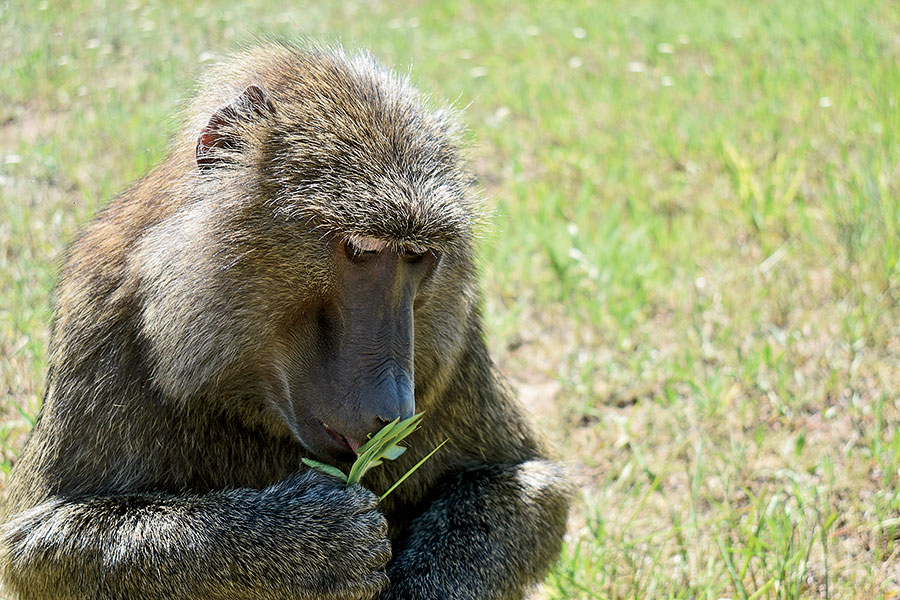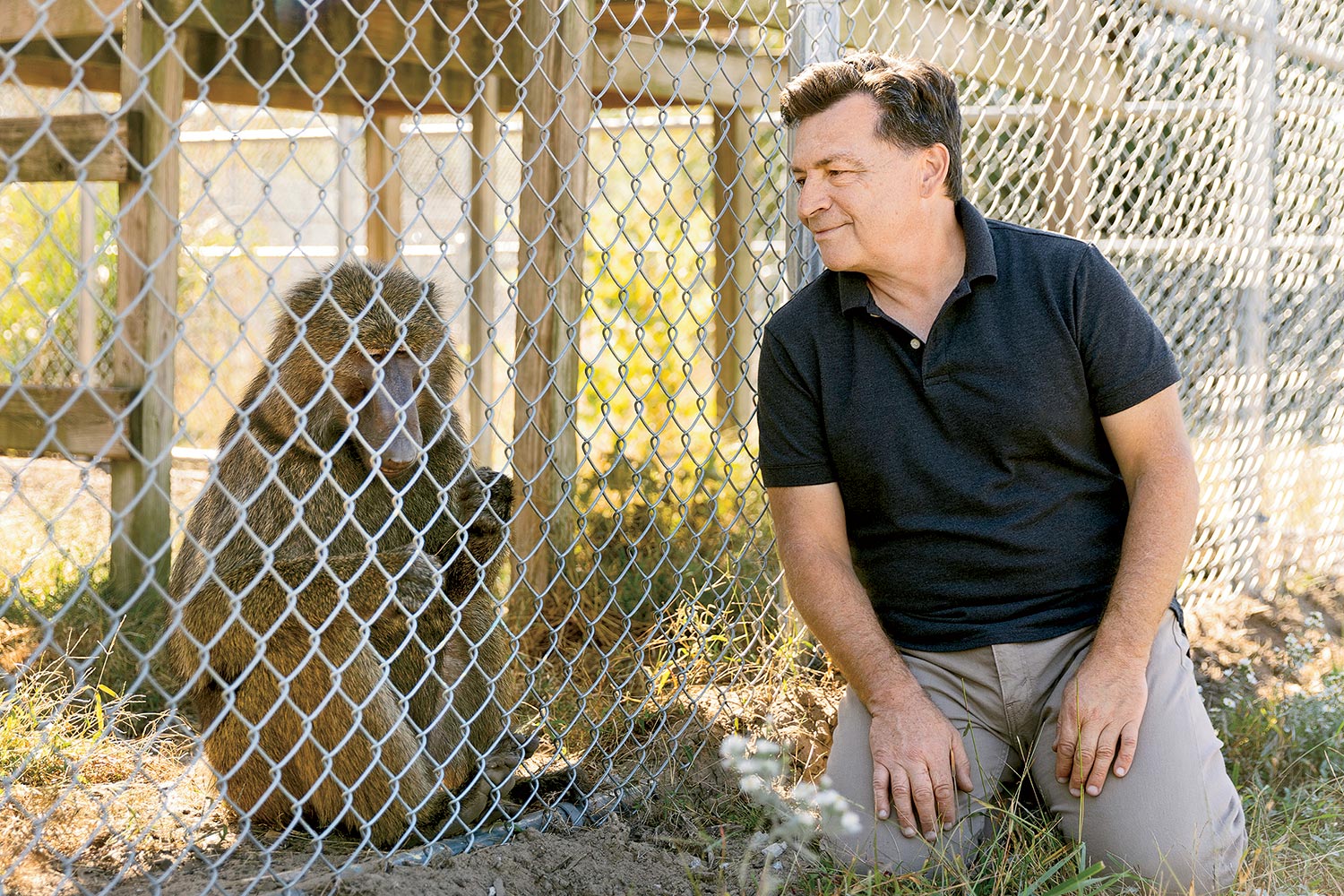I almost drove right past it the first time I visited. Bordered by fields of wheat and soy on a dusty country road in Winamac, the property could have been just another farm in northwest Indiana. The chainlink fence around its perimeter had the kind of large sliding gate you find in places with livestock. I could see a handful of buildings set back from the road at the end of a dirt driveway. As I inched my car toward the gate, the only sounds were the crunch of my tires and the singing of birds. Beside some industrial-size garbage cans, a filthy metal cage was tipped on its side, covered in dried food and feces. Two soiled infant blankets were balled up inside.
This was no farm. I was here, 100 miles from downtown Chicago, to volunteer for the day at Peaceable Primate Sanctuary, a refuge for monkeys retired from research labs or rescued from abusive owners. The cage I saw, tossed out with the trash, represented the end of a solitary indoor existence for a macaque named Dudley, who had been kept in a smoky, windowless room and fed a diet of junk food, including ketchup sandwiches, for 10 years by his former owner. He had arrived here, in that cage, the day before my visit.
Dudley was in a quarantine area for new arrivals, just off the large commercial kitchen, where I would help prep meals for the monkeys. Dudley was enjoying fruits, vegetables, and monkey biscuits — a nutritious dietary staple for these primates— while watching a movie on VHS (apparently monkeys like Steve Carell as much as I do) from his much larger and cleaner temporary cage. He was alert and curious as the sanctuary’s founder and director, Scott Kubisch, entered the building. Kubisch, in jeans and a faded T-shirt and with a full head of dark hair and the kind of tan you get from working outside, greeted Dudley with a warm “Hey there, buddy.” Dudley responded with lip smacks, a happy social primate behavior. Kubisch said he was looking forward to introducing Dudley to Sissy, an especially sweet female macaque he had chosen to become Dudley’s first-ever monkey companion, as soon as he cleared quarantine.
“Without other places to go, research primates would live out their entire lives in laboratory cages,” Kubisch says. “They might never see the sky.”
For the last decade, Kubisch has overseen this 80-acre private sanctuary, which I’ve visited several times over the past couple of years — a two-hour drive from the city. It’s a trip Kubisch knows well: He lives in west suburban Lyons. He no longer makes the drive every day — he stays at the facility most nights — but every weekend, he loads his dogs (two rescued borzois and a Spanish galgo) into his SUV and drives here to care for the macaques, baboons, and lemurs who live at the sanctuary. As of this October, there were 98 primates in Kubisch’s care, and he plans to welcome 30 more baboons by the spring.
On that first visit, Kubisch walked me through the property, down a path flanked by primate enclosures, baboons to our left and macaques to our right. Each enclosure consists of a small building attached to a spacious fenced-in outdoor area containing wooden platforms and large concrete tunnels for the monkeys to explore. Some enclosures have just one or two baboons or macaques; others, up to five. Monkeys relaxed on the platforms or in the grass, some of them grooming each other. But it took a minute to spot them. They were silent. And the enclosures were designed not for easy viewing of the animals, like in a zoo, but to give them room to roam. It was surreal. I’d seen wild baboons in Africa, but this was Indiana.
“Without other places to go,” Kubisch explained, “research primates would live out their entire lives in laboratory cages — if they are lucky enough to avoid terminal studies. They might never see the sky, a bird. They performed a valuable service, and now that their work is done, they deserve to live out the remainder of their lives with dignity, in comfort.”
Kubisch grew up in Lyons, where he developed an early obsession: “I was always reading about animals — books, magazines, encyclopedias, anything I could get my hands on.” His grandmother encouraged him to pursue a career as a zookeeper. As an adult, he took a job as a primate keeper at Brookfield Zoo, where he spent five years. Then he joined Lincoln Park Zoo as a “swing keeper,” assigned to care for not just one type of animal but all. (His favorites were the giraffes because, as he puts it, “they’re just cool.”) He worked there for 21 years.
One day, a supervisor decided to euthanize an animal in Kubisch’s care. It gnawed at him; Kubisch hadn’t agreed with the decision. He brought it up with his grandmother. Her advice? “Then you need to be the one in charge.”
It wasn’t long afterward, in early 2002, that Kubisch saw a video online of a baboon pacing in a laboratory cage. The sad image pushed him to take action. Later that year, he cashed in some of his retirement savings to purchase 40 acres near Winamac.
Friends thought he was crazy, not least because he had to beg for rides to Indiana while the facility was being built, since he didn’t have a car at the time. But that was the easy part. It would be 14 years before he welcomed his first monkeys — baboons Juniper, Violet, and Periwinkle — in 2016. The delay was mostly due to funding. Not only did Kubisch have to come up with money for construction and staffing, he had to have enough to support long-term care for the animals he took in. Just when Kubisch was close to giving up, a docent he had befriended at the Lincoln Park Zoo surprised him by leaving a sizable endowment for the project in her will.

Peaceable Primate Sanctuary is a retirement home of sorts, housing animals who were test subjects at pharmaceutical and cosmetic company labs or at university research facilities. Kubisch originally considered devoting his site to chimpanzees, but a friend pointed out that quite a few such sanctuaries already existed for them in the United States. There were not, however, any specifically for baboons or macaques, the monkeys that replaced chimps — our closest relatives in the animal kingdom — after the government phased out their use in labs in 2015.
These days, corporate and university labs regularly approach Kubisch with animals to take in. And while his focus is on those, he also accepts monkeys removed from abusive environments — not just neglectful pet owners but roadside zoos or shows without adequate space for large primates. (Before arriving at the sanctuary, three of the baboons lived in a wire pen with an overturned chest freezer as their only shelter.)
There are always more primates to rescue. Kubisch estimates 110,000 are housed in U.S. research labs. “If I have the space and can find enough qualified caregivers, I won’t turn animals away,” says Kubisch, whose office is filled with monkey figurines, stuffed animal monkeys, and other monkey artwork. He has even adopted several exotic birds, a turkey, peacocks, and a small African cat called a genet. (“I just couldn’t say no,” he tells me with a shrug.)
For Kubisch, the sanctuary has brought challenges beyond simply caring for all those animals. There’s keeping the books, fundraising, planning construction projects, and managing his staff: two office assistants, one vet tech, and seven animal care specialists, plus volunteers. “I’ve figured it out as I’ve gone along,” he says.
So what keeps him going? “It’s watching the firsts. Seeing a monkey who has lived his whole life indoors feel the sun on his face, watch a bird in a tree, or dig in the dirt for bugs. Or seeing one that has lived a solitary existence being groomed by another monkey. Natural, instinctual behaviors they haven’t gotten to experience before. Their whole demeanor changes as they settle in at the sanctuary. Their carriage is different. They have a new excitement. We had one anxious little macaque who took a full year to dare venture outdoors. We don’t force them to do anything. Seeing him finally sitting in the grass looking up at the sky was incredibly rewarding.”

We continued walking, and Kubisch introduced me to the baboons Olivia and Elsa, the sanctuary’s friendliest monkeys. Olivia immediately came up to the fencing of the enclosure she shares with Elsa, who hung back for a while before greeting us. Olivia picked grass and wildflowers and held them to her face. When it began to drizzle, Kubisch pointed out the baboon Amelia, who raced to the top of her platform to better feel the drops.
In the light rain, the baboons Dyson and Moses, who’d arrived at the sanctuary as a pair, played what felt like peekaboo but was probably just their way of covertly studying me from behind the posts of their raised platform. Kubisch laughed, telling me they get along with the female monkeys but don’t care for other males. Sissy, the macaque who was to become a companion to Dudley, seemed to be crushing on Kubisch, hurrying to the edge of her enclosure and keeping pace with him whenever we passed. She called out to him and flirted with him (for monkeys, that means looking and then looking away). “That’s my girl,” he called back to her.
Kubisch treats each animal at the sanctuary as an individual — not just in his interactions, but in his care. During my volunteer shift, I helped prep morning and evening food bowls, each one created for that monkey’s specific tastes and medical conditions: soft food for those missing teeth, low-sugar diets for diabetics, quantities of fruits and vegetables according to preference. We weighed out monkey biscuits based on each primate’s size and appetite and sliced and diced so many pounds of peppers, cucumbers, apples, and grapes that I couldn’t feel my thumb for days. (I may or may not have slipped a few extra grapes into Dudley’s bowl.) The produce is largely donated by local grocery stores, much of it bruised but usable. “Cut off any parts you wouldn’t want to eat,” a staffer told me.
Later, as we toured the indoor part of the monkey enclosures, Kubisch pointed out whiteboards documenting the individualized care the monkeys receive daily. Birth control for the girls. Anxiety meds for a baboon and two macaques. One of the boards even noted a root canal scheduled for a baboon.
In addition to traditional medical care, some residents are given alternative medicines. “We use natural remedies, like milk thistle for liver health,” Kubisch says. Some of the monkeys get CBD products — not so they can chill and gorge on monkey biscuits all day but for the aches and pains that come with age. Eighty percent of the sanctuary’s residents are in their midteens or older, with the average lifespan being 20 to 30 years.
When Kubisch discovered that one 17-year-old diabetic baboon could be lured with Red Vines licorice to the front of her enclosure for her daily insulin injection, he special-ordered a sugar-free version from the candy company.
On a subsequent visit, we stopped by an enclosure housing the turkey, a white bird named Betty White who had just arrived. “Miss Betty, I see you’ve still got a stomachache,” Kubisch cooed. “Let’s get your straw cleaned up.” He gave her a pat and raked away the mess.
Kubisch finished that tour by introducing me to a large troop of lemurs, confiscated from a roadside attraction, including a baby who had been removed from her mother and cruelly housed in a cage next to her: The two could see, hear, and smell each other but not touch or cuddle. They were reunited at the sanctuary, where they and the rest of the troop will soon have their own large outdoor space to roam in.
“You’ll have to come back,” Kubisch called to me as I headed toward my car. “We have marmosets arriving from three different universities.”
“Really?” I asked. Marmosets are my favorite kind of monkey.
“Yeah,” he said, “later this year. They are the smallest primates and are replacing other monkeys in a lot of labs now.”
And thanks to Kubisch, they’ll have a retirement home waiting for them when their work is done.



